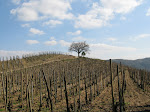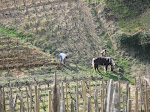
The color was nearly black and the aromas were just as dark. This big, firm wine wrestled with our palates, refusing to open up. "It must be a northern Rhone," commented one taster. I knew they were wrong since I had served the wine blind in a decanter. "No, it might be a syrah from California," stated another participant. The bottle was presented and everyone stared in shock. This was our first Dugat-Py.
The wines made by Bernard Dugat are sold under the Domaine Dugat-Py label in order to differentiate them from his cousin Claude Dugat. Both producers are known for a the dark, large scaled and some say, over extracted style of their wines. Dugat-Py is a true modern day Burgundian super star, but the domaine is also controversial. I was once told by a prominent critic that he puts very little few bottles from Dugat-Py in his own cellar, but this critic lavished a near perfect score on Dugat-Py's Le Chambertin. And he is not alone. Just about every critic who tastes in Dugat's cellar raves about the wines and scores them on par with DRC and Leroy. Yet, almost everytime I see Dugat-Py's name mentioned on Robert Parker's bulletin board, the person writing has been recently disappointed with a bottle and can not understand why there is so much hype surrounding the domaine. Why do the wines from Dugat-Py draw such a discrepancy in opinions?
Recently, I tasted two wines from Dugat-Py that made me think about the way this domaine is viewed and also made me wonder if Bernard has been slowly evolving his style.
Dugat-Py, Vosne-Romanee, Vieilles Vignes, 2005 - (suggested retail: $210) Dark color. Red fruits in nose with spice. Big and spicey on the palate, but also tannic. Very young. Hard to read at the moment.
Dugat-Py, Charmes-Chambertin, Grand Cru, 2005 - (sugested retail: $600) Very dark in color. Softer, sweeter nose. Same on the palate. Very pretty. Long finish. Excellent.
Tasting a wine from Dugat-Py for the first time, a wine industry professional commented that he was surprised by the style of the two wines listed above. I responded that I was also not expecting the Charmes to be so soft and accessible. The Vosne Romanee was more similar to wines I have tasted from the domaine in the past. My first experience with Dugat-Py had been a bottle of the 1999 Gevrey-Chambertin, 1er Cru tasted a few years ago and described above. I had expected to love this wine, especially after reading a quote from the Revue du Vin de France that said Dugat-Py's wines had a color that is "indescribable; of a blue-black that resembles the great Hermitages; the amplitude of their flesh, their fabulous velvetiness of texture, recall wines from legendary vintages of 1945, 1947 or 1959 without any of the defects of those vintages. Never in the past thirty years have we found an expression of terroirs of Gevrey so powerful..." I have since tasted several wines from Dugat-Py and none of them have been really enjoyable, usually just firm and unyielding. The quote from the Revue du Vin de France keeps ringing in the back of my head, however.
The late British writer Harry Waugh said the Burgundies were never the same after a large amount of replanting occurred following WWII. His theory being that the old rootstocks had much lower natural yields and this resulted in more concentrated berries with thicker skins. The wines from the pre-war era were said be very powerful in the best vintages and required many years of bottle age to be enjoyable. The same could be said of the wines being made today at Dugat-Py. Through a combination of pruning and very old vines the average yield for Dugat's wines are usually under 30 hl/ha; in 2003 they were below 20 hl/ha. The resulting wines are very dark, almost black, and very full in the mouth. A 2005 Morey-Saint-Denis, 1er Cru, Clos Sorbe from Jacky Truchot was tasted next to the two Dugat wines reviewed above and the difference in color was startling. The Truchot, whose yields were closer to 50 hl/ha, was ruby and one could see through the wine. This was not so for the Vosne or Charmes.
I visited the Dugat-Py domaine in July of 2005 and was struck by the seriousness of Bernard, whose stocky build and rough hands hint at the long days spent in the vineyards. The 2004's tasted from barrel had not yet gone through their malolactic fermentation and were very difficult to judge. Every cuvee smelled and tasted like grapefruit. However, just being in the cellar was a great experience. Dugat has one of the coolest, in both senses of the word, cellars in Burgundy. This former chapel, built in 1075, is pictured on the estate's labels and I can see how a journalist could become enchanted when tasting there. After the barrel tasting we sat in Bernard's kitchen and tasted two wines. The 2003 Gevrey-Chambertin, Coeur du Roy was still very tight and firm, but the 2003 Pommard, La Levriere, VV was full of super ripe fruit. Many of the 2003's I have tasted are very ripe, but this seemed extreme. While tasting the Pommard, I asked Bernard which wines are his favorite to drink, other than his own. He reponded "Zinfandel". Indeed, the wine in my glass was the closest thing to Zinfandel that I had ever tasted in Burgundy.
Older vintages from Dugat-Py are hard to come by, so my experience is limited, but a 1993, Gevrey-Chambertin, Coeur du Roy I drank a couple of years ago was hard and devoid of fruit. 1993 was a difficult year, so maybe this is not the right bottle from which to place judgment. The owner of the restaurant Ma Cuisine in Beaune told me that he likes the newer vintages from Bernard as they seem be less extracted. As a side note, Bernard claims that he does not do alot of extraction in his winemaking, which he refers to as "very natural and non interventionnist." The color and concentration, he says, are simply results of the low yields. The 2005 Charmes, with its soft texture and beautiful fruit, hints that maybe Bernard Dugat has tweaked his appraoch over the years.
As you can tell by having read this far, the bottles that emerge from domaine Dugat-Py are mysterious. Are the wines overworked creations or has Bernard Dugat found the secret to making great Burgundy as it might have tasted a century ago? I feel that some of the wines were too concentrated in the past, but not from overzealous winemaking. Rather it was obsessive vineyard work and yields that were too low. It might not be possible to produce a balanced wine from fruit harvested in the 20 hl/ha range when the source is a village level lieu-dit. That approach may be fine in the best vineyards, but perhaps not at the commune level. This may explain why there are excessive tannins present in the 2005 Vosne Romanee, but not in the 2005 Charmes-Chambertin.
Debating issues such as this are part of what make Burgundy and domaines such as Dugat-Py so interesting. It is all about personal taste and no one can be proven to be right or wrong. Bernard Dugat's wines may not be for everyone, but they are clearly made by a vigneron with a lot of passion, and that alone makes them worth tasting and debating.










1 comment:
Just came across your comments on the 1999 Charmes Chambertin Dugat-Py. I am opening one at a tasting in 2 weeks. I will try and update you with our opinion after the tasting.
CC
Post a Comment